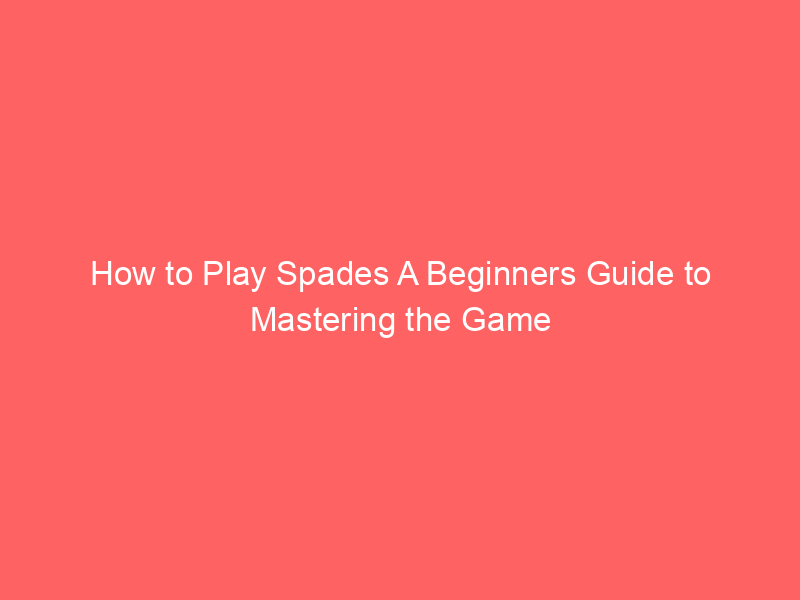Embark on an exhilarating journey into the world of Spades! This classic card game has captivated card enthusiasts for centuries, demanding strategy, skill, and a dash of luck. Whether you’re a seasoned pro or a curious novice, this comprehensive guide will lead you through the intricacies of Spades, empowering you to master its nuances and triumph at the table.
As we delve into the rules, strategies, and winning techniques, you’ll discover why Spades remains a beloved game, fostering camaraderie, competitive spirit, and countless hours of entertainment.
How to Play Spades
Spades is a classic card game that can be enjoyed by people of all ages. It is a trick-taking game, which means that players try to win tricks by playing cards that are higher than the cards played by their opponents.
The game is played with a standard deck of 52 cards, and the goal is to be the first player or team to reach 500 points.
Spades is a relatively easy game to learn, but it can be difficult to master. There are many different strategies that players can use to improve their chances of winning, and the best way to learn how to play is to practice regularly.
The Basics of Spades
Spades is played with four players, who are divided into two teams of two. The players on each team sit across from each other, and the game is played clockwise.
The first player to deal is chosen randomly, and the dealer deals 13 cards to each player. The remaining cards are placed in a pile in the center of the table, and the top card of the pile is turned over to start the discard pile.
The player to the left of the dealer leads the first trick by playing any card they want. The other players must then play a card of the same suit if they have one. If they do not have a card of the same suit, they can play any card they want.
The player who plays the highest card of the suit that was led wins the trick and collects all of the cards that were played. The winner of the trick then leads the next trick.
Bidding in Spades
Before the first trick is played, each player must bid on the number of tricks they think they will take. The minimum bid is 1, and the maximum bid is 13. Players can also bid “nil,” which means that they think they will not take any tricks.
The bids are added up, and the team with the highest total bid is the “declaring team.” The declaring team must then try to take at least the number of tricks they bid. If they succeed, they score 10 points for each trick they take over their bid.
If they fail, they lose 10 points for each trick they fall short of their bid.
Scoring in Spades
The first team to reach 500 points wins the game. Points are scored for taking tricks and for bidding correctly. Taking a trick is worth 10 points, and bidding correctly is worth 1 point per trick bid.
If a player bids nil and takes no tricks, they score 100 points. If a player bids nil and takes one or more tricks, they lose 100 points.
Tips for Playing Spades
Here are a few tips for playing spades:
- Pay attention to the cards that have been played and try to track which suits are strong and which are weak.
- Be careful about leading with your high cards, especially if you have a weak suit.
- Try to communicate with your partner by signaling to them which cards you have.
- Don’t be afraid to bid nil if you think you have a weak hand.
- Have fun! Spades is a great game to play with friends and family.
Advanced Strategies for Spades
Once you’ve mastered the basics, you can start to explore more advanced strategies to improve your chances of winning.
One important strategy is to learn how to count cards. By keeping track of which cards have been played, you can get a better idea of which cards are still in the deck and which suits are strong or weak.
Another important strategy is to learn how to communicate with your partner. There are many ways to do this, such as using signals or simply talking to each other between tricks.
Finally, it’s important to be able to adapt your strategy based on the situation. For example, if you have a weak hand, you may want to bid nil. Or, if you have a strong hand, you may want to bid high to try to force your opponents to take tricks.
Variations of Spades
There are many different variations of spades, each with its own unique set of rules. Some of the most popular variations include:
- Blind nil: In this variation, players must bid nil without looking at their cards.
- Suicide spades: In this variation, players can only bid nil if they have a very weak hand.
- Cutthroat spades: In this variation, there are no teams, and each player plays for themselves.
These are just a few of the many different variations of spades that you can try. If you’re looking for a new challenge, give one of these variations a try!
Conclusion
Spades is a classic card game that can be enjoyed by people of all ages. It’s a great game for developing your strategic thinking and communication skills.
Whether you’re a seasoned pro or a curious novice, I encourage you to give spades a try. With a little practice, you’ll be able to master the nuances of the game and triumph at the table!
